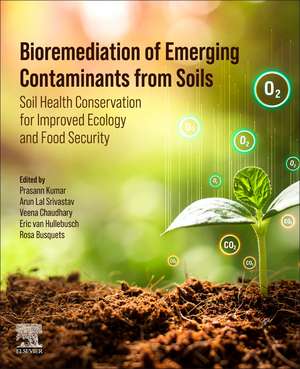Bioremediation of Emerging Contaminants from Soils: Soil Health Conservation for Improved Ecology and Food Security
Editat de Prasann Kumar, Veena Chaudhary, Eric D. van Hullebusch, Rosa Busquets, Arun Lal Srivastaven Limba Engleză Paperback – 8 mai 2024
Designed to highlight soil health best practices for both environmental and agricultural sustainability, these approaches are also considered important for improving global food security by ensuring safe growing conditions for crops for food and feed. Presented in two parts, this book first highlights emerging contaminants and their sources. The second part explores a variety of steps and tools for addressing contaminated soils, including bio- and phytoremediation options. Case studies in each part provide real-world insights for practical application.
- Contains the latest practical and theoretical aspects of the soil health crisis and its management
- Presents collective information to ensure the remediation of soil from emerging contaminants
- Serves as baseline information for environmental issues in agriculture along with their alternative eco-friendly solutions
Preț: 669.90 lei
Preț vechi: 877.34 lei
-24% Nou
Puncte Express: 1005
Preț estimativ în valută:
128.19€ • 137.07$ • 106.88£
128.19€ • 137.07$ • 106.88£
Carte tipărită la comandă
Livrare economică 11-25 aprilie
Livrare express 13-19 martie pentru 79.98 lei
Preluare comenzi: 021 569.72.76
Specificații
ISBN-13: 9780443139932
ISBN-10: 0443139938
Pagini: 724
Dimensiuni: 191 x 235 x 38 mm
Greutate: 0.45 kg
Editura: ELSEVIER SCIENCE
ISBN-10: 0443139938
Pagini: 724
Dimensiuni: 191 x 235 x 38 mm
Greutate: 0.45 kg
Editura: ELSEVIER SCIENCE
Cuprins
CHAPTER 1 Exponential population growth and global food security: challenges and alternatives
CHAPTER 2 Agricultural soil contamination due to industrial discharges: challenges for public
health protection and food security
CHAPTER 3 Traditional approaches of agriculture soil remediation: boon or bane for global food security
CHAPTER 4 Polycyclic aromatic hydrocarbons bioremediation mechanisms by nonligninolytic fungi: a multiscale approach
CHAPTER 5 Phenolic compounds: a significant threat to agricultural soils
CHAPTER 6 Pharmaceutical compounds: a recent threat to agricultural soils (sources, transport, and negative impacts on the crop’s quality and other adjacent ecosystems)
CHAPTER 7 Sources of inorganic nonmetallic contaminants (synthetic fertilizers, pesticides) in agricultural soil and their impacts on the adjacent ecosystems
CHAPTER 8 Sources of inorganic metallic contaminants (lead, cadmium, arsenic, etc.) in agricultural soil and their impacts on the adjacent ecosystems
CHAPTER 9 Environmental threats posed by xenobiotics
CHAPTER 10 Bioremediation of xenobiotic contamination in soil
CHAPTER 11 Transgenic plants as a source of xenobiotic remediation
CHAPTER 12 Xenobiotic stress management by microbial endophytes
CHAPTER 13 Case studies on emerging contamination of soil
CHAPTER 14 Bioremediation of metal-contaminated soil: comparison of microbial agents with plants
CHAPTER 15 Phytoremediation of metal contaminated soil using energy crops: soil health maintenance along with biofuel production
CHAPTER 16 Phytoremediation of phenolic compounds from soil
CHAPTER 17 Phytoremediation of pharmaceutical compounds in soil
CHAPTER 18 Alternative natural options of synthesized agrochemicals
CHAPTER 19 Role of enzymes in the optimization of traditional phytoremediation processes of soil
CHAPTER 20 Optimized phytoremediation process for the sustainable management radionuclides
CHAPTER 21 Role of indigenous knowledge in agricultural soil reclamation without disturbing other ecosystems
CHAPTER 22 Role of hyperaccumulators in the reduction of emerging industrial pollutants from soil
CHAPTER 23 Microbes-assisted bioaugmentation process in the reduction of emerging industrial pollutants from soil
CHAPTER 24 Application of genetically modified crops against metallic contaminations
CHAPTER 25 Crop rotation patterns and soil health management
CHAPTER 26 Application of microphytes for soil reclamation
CHAPTER 27 Utilization of genetically modified weed plants against industrial contaminants: a promising tool of phytoremediation
CHAPTER 28 Case studies on management practices for emerging contamination of soil, challenges and future scope
CHAPTER 2 Agricultural soil contamination due to industrial discharges: challenges for public
health protection and food security
CHAPTER 3 Traditional approaches of agriculture soil remediation: boon or bane for global food security
CHAPTER 4 Polycyclic aromatic hydrocarbons bioremediation mechanisms by nonligninolytic fungi: a multiscale approach
CHAPTER 5 Phenolic compounds: a significant threat to agricultural soils
CHAPTER 6 Pharmaceutical compounds: a recent threat to agricultural soils (sources, transport, and negative impacts on the crop’s quality and other adjacent ecosystems)
CHAPTER 7 Sources of inorganic nonmetallic contaminants (synthetic fertilizers, pesticides) in agricultural soil and their impacts on the adjacent ecosystems
CHAPTER 8 Sources of inorganic metallic contaminants (lead, cadmium, arsenic, etc.) in agricultural soil and their impacts on the adjacent ecosystems
CHAPTER 9 Environmental threats posed by xenobiotics
CHAPTER 10 Bioremediation of xenobiotic contamination in soil
CHAPTER 11 Transgenic plants as a source of xenobiotic remediation
CHAPTER 12 Xenobiotic stress management by microbial endophytes
CHAPTER 13 Case studies on emerging contamination of soil
CHAPTER 14 Bioremediation of metal-contaminated soil: comparison of microbial agents with plants
CHAPTER 15 Phytoremediation of metal contaminated soil using energy crops: soil health maintenance along with biofuel production
CHAPTER 16 Phytoremediation of phenolic compounds from soil
CHAPTER 17 Phytoremediation of pharmaceutical compounds in soil
CHAPTER 18 Alternative natural options of synthesized agrochemicals
CHAPTER 19 Role of enzymes in the optimization of traditional phytoremediation processes of soil
CHAPTER 20 Optimized phytoremediation process for the sustainable management radionuclides
CHAPTER 21 Role of indigenous knowledge in agricultural soil reclamation without disturbing other ecosystems
CHAPTER 22 Role of hyperaccumulators in the reduction of emerging industrial pollutants from soil
CHAPTER 23 Microbes-assisted bioaugmentation process in the reduction of emerging industrial pollutants from soil
CHAPTER 24 Application of genetically modified crops against metallic contaminations
CHAPTER 25 Crop rotation patterns and soil health management
CHAPTER 26 Application of microphytes for soil reclamation
CHAPTER 27 Utilization of genetically modified weed plants against industrial contaminants: a promising tool of phytoremediation
CHAPTER 28 Case studies on management practices for emerging contamination of soil, challenges and future scope
